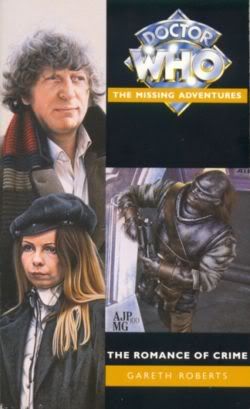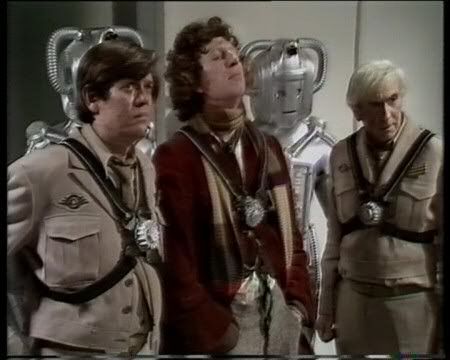 An audio adventure featuring the Eighth Doctor and Charley
An audio adventure featuring the Eighth Doctor and CharleyWritten by Rob Shearman and directed by Barnaby Edwards
Polarity Rating: 3.5 out of 5
Imagine my festive frivolity when, randomly choosing my next Big Finish production to review in mid-December, a story presented itself that was set on Christmas Eve. Not only that, but the blurb on the back of the CD suggested it was some kind of Edwardian murder mystery. Sign me up, I said, and quickly went about listening to it so that I could post my review on this very day, Christmas Eve itself.
A quick word about Christmas stories and Doctor Who. When a story is set on Christmas, it never is about Christmas per se, but rather it involves some kind of an alien invasion set on Christmas Day (one obvious exception is the single episode aired on Christmas Day for "The Daleks' Master Plan," which I have not yet had the pleasure to listen to). There may be robot Santas wielding laser guns and a festive holiday party about to be torn to shreds by a tragedy a la The Poseidon Adventure, but I would love to see or hear a story that involves the concept of Christmas itself as a basis for the plot. (I would refer anyone seeking such a story to the recent Iris Wildthyme adventure, The Claws of Santa, which really hits the nail on the head in this department.) Such is the case with The Chimes of Midnight. There is a great deal of talk about Christmas pudding, one or two carols are sung in passing, but other than that the thing could have been set on Saint Swithen's Day and we would have had the same story.
Not that I have any huge gripes with most of the story. When the TARDIS materializes in the pantry of a country estate in 1906, the Doctor and Charley are involved with the comings and goings of five members of the household staff. Strangely, nothing is heard from the gentry having a Christmas party upstairs, and indeed when the Doctor tries to ascend to the upper levels of the house, he is deterred with unexplainable and uncharacteristic threats of violence from the staff. It's not long before a murder occurs and, in true Ten Little Indians fashion, the staff begin to be bumped off one by one, each at the grandfather clock's striking of the hour: the scullery maid, for instance, is found drowned in the washing basin, and the cook is found sprawled across the kitchen table, force-fed her infamous Christmas pudding to death. These events may seem like spoilers, except that the same characters inexplicably show up minutes later alive and well, oblivious to the fact that they were found murdered moments before. The Doctor and Charley and the listener, of course, are baffled.
This was the perfect setup for a wonderful cosmic mystery. Why are the characters admittedly unsure whether or not they could be the murderer? Why do the household duties of each of the characters change every time they return from the dead? Why do they recognize the Doctor as some kind of famous amateur sleuth? Through the first three episodes, I thought I had it all figured out: of course, I figured, the Doctor and Charley were stuck in some sort of land of fiction as in "The Mind Robber," where an author of whodunnits was constantly rewriting a draft of his latest murder mystery, never quite sure who the proper murderer should be in the end or even the right victim.
My solution, needless to say, was not the correct one. Unfortunately, the true solution to the mystery would have led me to give this story a 4.5 rather than a 3.5 if it didn't leave me scratching my head. I suppose there are fanboys and fangirls out there who love stories involving paradoxes and time folding in on itself, but these type of stories rarely work for me unless they're spelled out for me like I'm a nine-year-old (the old favorite "Blink" comes to mind). In all fairness, I could go back and listen to the last episode, but I just don't think that would be proper. Why go back and listen to a story and purposely look for the good things when the writer and/or director failed to get the point across the first time?
I rarely think this when listening to Big Finish stories, but this one would have been a wonderful televised story for Christmas Day. There were certain passages here that would have translated better on the screen, and the holiday element could have been used a bit more than it was. If Paul Cornell could translate his novel Human Nature so well on to the screen, I say let Rob Shearman have his pick of a few audio adventures, definitely including The Chimes of Midnight, and see what magic he can make of those. He is, after all, the writer who brought us Dalek, for some the epitome of the perfect Dalek episode in the new series.
If you're new to Big Finish (or to the Eighth Doctor adventures), I'm told by folks on the forums that The Chimes of Midnight is one of the best out there. I beg to differ. Pick up a copy of Sword of Orion or Storm Warning instead. Unless, of course, you're one of those fans who love to put the 10% of the missing pieces of a puzzle together yourself. In that case, perhaps you have a better imagination than I and more power to you.
Fun Facts:- The character names for Shaughnessy, the butler, and Mrs. Baddely, the cook, were derived from the names of the script editor and the actress who played the cook in the classic British show Upstairs, Downstairs.
- These are not the only characters to glean inspiration from Upstairs, Downstairs; Edith, the scullery maid from The Chimes of Midnight, bears a striking resemblance to the feather-brained scullery maid Ruby in Upstairs, Downstairs.


